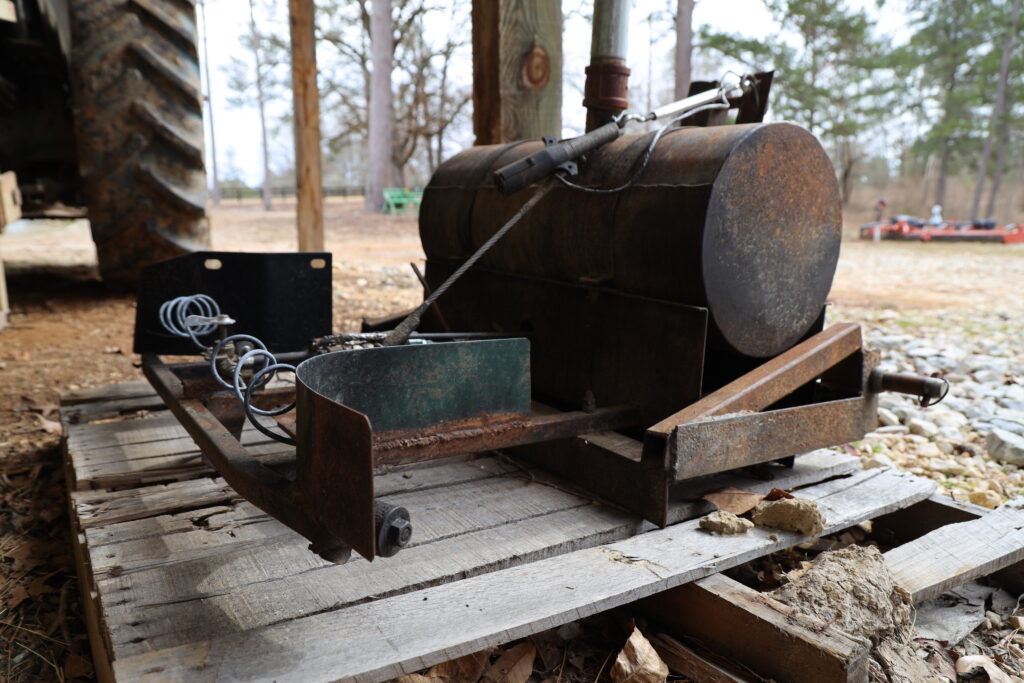Controlled Burns Build Back Better Browse

By Tanner Hood
Smoke rises and flames snap, crackle and pop through forest undergrowth as Scott Woodall uses a drip torch to ignite a controlled burn in remote Jackson County.
“Fire can be used to promote better wildlife habitat and knock back competition so desired trees and plants can capitalize on the water and nutrients not being consumed by unwanted vegetation,” said Woodall, founder of Sportsman’s Wildlife and Timber, a habitat management company for local landowners.
Controlled burning, a practice originally attributed to Native Americans, is growing in popularity, said Woodall.
For many, fire that spreads across acres is associated with uncontrolled blazes in places like California where lack of planned burns has left land coated in ready fuel. Fire in that vein is unlikely in Alabama, Woodall said.
“I don’t believe the climatic conditions exist normally for us to be at quite as high of a risk like they are on the West Coast,” Woodall said. “Active forest management helps mitigate those issues.”

Alabama’s climate offers ideal times to burn, Woodall said.
“Most burning is in the winter and spring because it can be difficult to burn in Alabama humidity,” said Woodall, the Jackson County Farmers Federation secretary and Alabama Farmers Federation State Forestry Committee member. “Weather is also an obstacle because it’s so unpredictable.”
When the fires eventually get going and smoke starts rolling, burns can be beneficial for landowners.
Woodall is a prescribed burn manager, which means he’s certified to conduct effective and reliable burns. However, landowners with appropriate equipment and manpower can request a burn permit through the Alabama Forestry Commission.
“When we burn for a landowner, our objective is reaching their goals for what they want out of the land,” Woodall said. “Fire breaks are then established to help prevent escapes, and fire is applied.”
For Woodall’s clients, goals include promoting better wildlife habitat, improving native browse and site-prepping timber land after clear-cutting.

Auburn University Associate Professor of Wildlife Ecology and Management Dr. William Gulsby said controlled burns are an effective way to reach those targets.
“Controlled burning, also known as prescribed fire, is a cost-effective tool to manage vegetation communities for a variety of game and non-game wildlife species,” Gulsby said. “For example, prescribed fire reduces the height of vegetation. This ensures cover from inclement weather and predators is readily available for ground-dwelling wildlife and keeps food sources within reach.
Controlled burning also increases the palatability, nutrient content, digestibility, productivity and prevalence of important forage plants while promoting popular game-species growth, Gulsby said.
“Periodic fire is a cost-effective way to increase habitat quality for our state’s most popular game species: white-tailed deer and wild turkeys,” Gulsby said. “There are also several game and non-game species that only inhabit areas that are frequently burned. For example, northern bobwhite quail, red-cockaded woodpeckers, gopher tortoises and Bachman’s sparrows disappear completely from areas about five years after burning.”
Ideal quail habitat pushes Gary Bryant to rely on prescribed fire.
“Fire is the best tool in the box,” said Bryant, who manages Kowike Creek in Russell County and is a member of the State Wildlife Committee. “It’s the cheapest and easiest method to kill unwanted vegetation and promote cover and food for the quail.”

With over 3,000 acres to manage, Bryant has developed a burn rotation to maximize growth. Land is sectioned off with separate portions being burned in different years.
Innovative ideas make burning effective for Bryant’s operation. That includes using previously established roads as fire breaks and a homemade drip torch attachment for a tractor.
“I use a tractor with an electric burner and fuel tank,” Bryant said. “It’s wired to my turn signals, so when I flip the indicator, fire comes out of that side of the tank. I tell everyone they better watch out when they see my signal.”
Tending the fire isn’t a one-man job. Bryant typically has two others on four-wheelers and tractors with water tanks and sprayers to prevent accidental spread and keep the fire under control.
He’s also aware of shifts in weather patterns, like wind, that affect burns.
“It’s all necessary for beneficial growth and wildlife development,” Bryant said. “We want wax myrtles to grow like bushes for quail cover, and it takes fire. We plant partridge peas and ragweed for deer and turkeys, but we must burn the area to plant. For us, it revolves around the fire.”

Federation Wildlife Division Director William Green said he’s thankful to see revived interest in controlled burns.
“We encourage our landowners to use fire in a safe, responsible and productive way,” Green said. “Burns are becoming more commonplace and, when used correctly, allow wildlife and vegetation to grow in ways not seen in decades.”
Back in Jackson County, Woodall examined sprigs of new green grass rising through the char of a recent fire.
“Burning has a place in our ecosystem,” Woodall said, “and as stewards of the land, we must use it proactively.”
